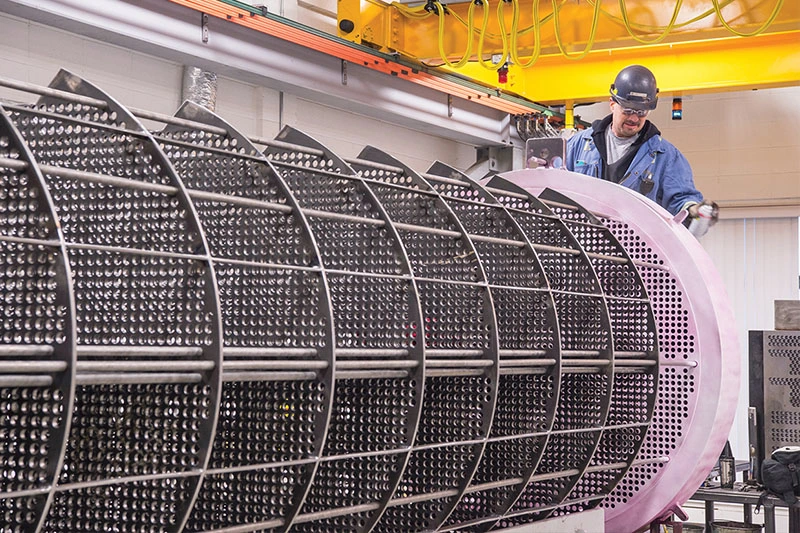
Process Equipment Design (Desain Proses Peralatan)
Kursus ini memberikan penjelasan secara heuristik saat melakukan desain dasar dan prinsip kerja berbagai proses peralatan yang umum digunakan untuk pipa, peralatan aliran dan peralatan pemisahan serta mempelajari konsep dasar tata letak peralatan dan sistem perpipaan dengan melakukan studi kasus dalam perancangan tata letak peralatan pabrik menggunakan software desain pabrik.
References:
- Couper, J. R., Penney, W. R., Fair, J. R., & Walas, S. M. (2012). Chemical Process Equipment: Selection and Design (3rd ed.). Butterworth-Heinemann.
- Towler, G. & Sinnott, R. (2013). Chemical Engineering Design: Principles, Practice, and Economics of Plant and Process Design (2nd ed.). Butterworth-Heinemann.
- Green, D. W. & Perry, R.H. (2008). Perry’s Chemical Engineering Handbook (8th ed.). McGraw-Hill.
Course Fee
Reviews
Schedule
Appointment with tutor(s)
Registration
Fluid Transport Equipment: Piping Systems
Pipe is used to transport fluids in process industries and daily life. This session includes materials about:
- Pressure Drop in Pipes and Pipe Fittings
- Pipe Wall Thickness, Pipe Size Selection, and Nominal Pipe Size (NPS)
- Control Valves Sizing
- Heuristics in Piping Design
Fluid Transport Equipment: Pumps and Compressors
Pump and compressor is used to provide energy to fluids, because of the energy loss by pipe friction. The materials discussed includes:
- Pump Theory
- Criteria for Pumps Selection
- Blowers, Fans, and Compressors
- Criteria for Compressors Selection
- Heuristics in Pump, and Compressor Design
Heat Exchangers: Single Phase Process
This session discuss about designing heat exchanger without invloving phase change, which also discuss:
- Basic Design Procedure and Theory
- Mean Temperature Difference
- Overall Heat Transfer Coefficient and Fouling Factors
- Types of Heat Exchangers
- TEMA Standards and Data Sheets
- Shell and Tube Exchangers Design without Phase Change
- Heuristics in Heat Exchangers Design
- Software: ASPEN Exchangers Design and Rating (EDR) or HTRI
Heat Exchangers: Process Involving Phase Change
This session will design heat exchanger, considering phase change in the process, and also discuss:
- Condensers
- Reboilers
- Evaporators
- Double Pipe Heat Exchangers
- Fired Heaters
- Heuristics in Heat Exchangers Design
- Solving the Problems with Computer Aid (Aspen Exchanger Design and Rating (EDR), HTRI, etc.)
Separation Towers: Distillation and Gas Absorption
This session discuss materials in:
- Vapor-Liquid Equilibria
- Single-stage Flash Calculations
- Binary Distillation (McCabe-Thiele Method)
- Batch Distillation
- Multicomponent Separation (Fenske-Underwood-Gilliland Method)
- Gas Absorption and Stripping Process
- Criteria for Selection of Separation Methods
Separation Towers: Mechanical Design
This session focuses on mechanical design of separation tower, which includes:
- Tray Towers Design
- Packed Towers Design
- Efficiencies of Trays and Packing
- Condenser and Reboiler Load
- Distillation Towers Sequencing
- Heuristics in Separation Towers Design
- Solving the Problems with Computer Aid (Aspen Hysys, Aspen Plus, etc.)
Separation Towers: Liquid-Liquid Extraction
This session discuss materials in:
- Ternary Diagram
- Solvent Selection
- Calculation of Stage Requirements
- Countercurrent Operation
- Equipment for Extraction
Pressure Vessel: Design Considerations
This session discuss materials in:
- Pressure Vessels Code and Standards
- Design Pressure and Temperature
- Materials Selection
- Maximum Allowable Stress and Welding-Joint Efficiency
- Corrosion Allowance
- Design of Vessels under Internal Pressure (Shell Thickness and Selection of Head and Closure)
- Design of Vessels under External Pressure
Pressure Vessels: Design Subject to Combined Loading
This session discuss materials in:
- Pressure Load
- Dead Weight of Vessel and Contents
- Wind
- Earthquake
- External Loads Imposed by Piping and Attached Equipment
Pressure Vessel: Process Vessels Design
This session is designing process vessel in general, which includes:
- Gas-Gas Separation - Adsorption
- Gas-Liquid Separators - Horizontal and Vertical Separators
- Liquid-Liquid Separators - Decanters
Dryers and Cooling Towers
These equipments can be tricky to design, so the materials that will be discussed are:
- Humidity and Psychrometric Chart
- Rate of Drying
- Classification and General Characteristics of Dryers
- Batch Dryers
- Continous Tray and Conveyor Belt Dryers
- Rotary Cylindrical Dryers
- Spray Dryers
- Cooling Towers
Mixing and Agitation
Mixing equipments use fluid mechanic concepts to design. So, the matrials discussed in this session covers:
- A Basic Stirred Tank Design (Geometry and Impellers)
- Vessel Flow Patterns
- Agitator Power Requirements
- Pipeline Mixers Design
Transfer of Solids
Solids are hard to transport. The materials discussed in this session will cover:
- Slurry Transport
- Pneumatic Conveying
- Mechanical Conveyors and Elevators
- Chutes
- Solids Feeders

